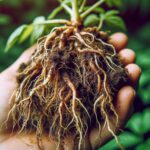Root rot is a silent yet devastating threat to a wide range of crops, from vegetables and fruits to ornamental and forest plants. This disease, caused by various fungal and bacterial pathogens that thrive in waterlogged and poorly drained soil conditions, attacks the root system of plants, disrupting their vital ability to absorb water and essential nutrients. If not managed properly, root rot can lead to significant losses in yield, crop quality, and even plant death. This comprehensive guide explores in depth the causes, symptoms, prevention strategies, and control tactics to help farmers and gardeners protect their crops from this insidious disease.
Understanding the Threat: Causes, Symptoms, and Risk Factors of Root Rot
Invisible Triggers: Common Pathogens of Root Rot
Root rot is a complex problem that can be caused by a variety of pathogenic microorganisms present in the soil. Some of the most common fungi involved include species of the genera Phytophthora, Pythium, Rhizoctonia, and Fusarium. Bacteria, although less frequent as a primary cause, can also contribute to or exacerbate the disease under certain conditions. These pathogens are opportunistic, capable of infecting plant roots when environmental conditions are favorable, especially water saturation and lack of oxygen in the soil.
Early Warning Signs: Identifying the Symptoms of Root Rot
Early detection of root rot can be crucial for implementing effective control measures and preventing significant losses. However, the initial symptoms are often subtle and can be confused with other conditions, such as lack of water or nutrients. The most common symptoms include:
- Wilting: Plants may show signs of wilting even when the soil is moist, as damaged roots cannot efficiently transport water.
- Yellowing of Leaves (Chlorosis): The lack of absorption of essential nutrients, such as nitrogen and iron, can lead to yellowing of the leaves, usually starting with the older leaves.
- Stunted Growth: Affected plants may show slow and weak growth compared to healthy plants.
- Discoloration and Decomposition of Roots: Upon examining the roots, a discoloration (from white to brown or black), a soft and watery texture, and a smell of decomposition will be observed. The outer roots may easily slough off, leaving only the central vascular cylinder.
- Crown Rot: In some cases, the rot can extend to the crown of the root, the area where the stem joins the roots, causing it to soften and darken.
- Plant Death: In advanced stages, the plant’s inability to absorb water and nutrients leads to its collapse and death.

The Perfect Scenario: Factors that Predispose to Root Rot
Several factors can create an environment conducive to the development of root rot:
- Poor Soil Drainage: Heavy, compacted soils or those with impermeable layers hinder the movement of water and air, leading to saturation and lack of oxygen, ideal conditions for the growth of anaerobic pathogens such as Phytophthora and Pythium.
- Overwatering: Watering too frequently or in excessive amounts keeps the soil constantly saturated, depriving roots of oxygen and favoring pathogen activity.
- Poor Soil Aeration: Soil compaction, caused by constant traffic or improper tillage, reduces porosity and air circulation, affecting root health and increasing susceptibility to rot.
- Use of Moisture-Retaining Growing Media: In pots or containers, the use of media that retain too much moisture, especially if there is no adequate drainage, can predispose to root rot.
- Transplanting with Damaged Roots: Roots damaged during transplanting can become entry points for soilborne pathogens.
- Contamination of Soil and Tools: Root rot pathogens can persist in the soil for long periods and can spread through contaminated gardening tools or agricultural machinery.
- Nutritional Imbalances: Although not a direct cause, deficiencies or excesses of certain nutrients can weaken plants and make them more susceptible to root diseases.
Comprehensive Prevention Strategies: Building a Solid Defense
Prevention is the most effective strategy for managing root rot. Implementing the following practices can significantly reduce the risk of its occurrence:
- Improve Soil Drainage:
- Incorporation of Organic Matter: The addition of compost, worm castings, or other organic materials improves soil structure, increases porosity, and facilitates drainage.
- Proper Tillage: In compacted soils, deep tillage can help break up impermeable layers and improve aeration. However, avoid excessive tillage that can damage soil structure in the long term.
- Creation of Raised Beds or Mounds: In areas with poor drainage, planting on raised beds or mounds ensures that the roots are above the water saturation level.
- Installation of Drainage Systems: In severe cases, it may be necessary to install underground drainage pipes to remove excess water.
- Smart Watering Practices:
- Watering Based on Need: Water only when the top layer of soil is dry to the touch. The frequency and amount of watering should be adjusted to the specific needs of the crop, soil type, and climatic conditions.
- Deep and Infrequent Watering: Encourage the development of deep roots by watering thoroughly but less frequently, rather than shallow and frequent watering.
- Avoid Waterlogging: Ensure that pots and containers have adequate drainage holes and prevent water from accumulating in saucers.
- Promotion of Soil Aeration:
- Avoid Compaction: Minimize foot and machinery traffic in growing areas, especially when the soil is wet.
- Mechanical Aeration: In lawns and some crops, mechanical aeration with spikes or hollow tines can improve air circulation in the soil.
- Selection of Appropriate Growing Media:
- Well-Draining Mixtures: When growing in pots or containers, use substrate mixtures that provide good drainage and aeration, such as peat-based, perlite, vermiculite, or coconut coir mixes.
- Hygienic Management:
- Disinfection of Tools: Clean and disinfect gardening and agricultural tools with a 10% bleach solution or 70% isopropyl alcohol between use on different plants to prevent the spread of pathogens.
- Use of Healthy Seeds and Seedlings: Acquire seeds and seedlings from reliable and certified disease-free sources.
- Crop Rotation: In agriculture, rotating crops with species that are not susceptible to the same root pathogens can help reduce the buildup of these pathogens in the soil.
- Use of Resistant Varieties and Grafting Stocks: Some crop varieties and grafting stocks offer greater resistance to certain root rot pathogens.
Active Control Strategies: Intervening When Disease Strikes
If root rot has already affected your crops, the following measures can help control its spread and, in some cases, save affected plants:
- Accurate Diagnosis: Identifying the specific pathogen involved through soil or root tissue analysis can help select the most effective treatment.
- Immediate Improvement of Drainage: If the soil is waterlogged, suspend watering and take steps to improve drainage, such as aerating the soil around the plant or transplanting to better-draining soil.
- Pruning Affected Roots: Carefully unearth the plant and prune away soft, dark, and decaying roots with clean, disinfected shears.
- Application of Fungicides: There are specific fungicides for the control of root rot pathogens, such as those targeting Phytophthora (e.g., fosetyl-aluminum) or Pythium (e.g., propamocarb). Application should be done according to the manufacturer’s recommendations, and soil treatment is often required. Systemic fungicides may be more effective as they are absorbed by the plant.
- Biological Treatments: Some products containing beneficial microorganisms, such as Trichoderma, can help suppress root rot pathogens and promote root system health.
- Soil Amendments: The application of amendments such as gypsum can help improve soil structure and drainage in clay soils.
- Watering Management: Drastically adjust watering practices to avoid soil saturation.
- Isolation of Affected Plants: If possible, isolate infected plants to prevent the spread of the disease to healthy plants.
Conclusion: A Proactive Approach for Healthy Roots and Productive Crops
Root rot poses a serious threat to the health and productivity of crops. However, with a thorough understanding of its causes and symptoms, and the implementation of comprehensive prevention and control strategies, farmers and gardeners can significantly minimize its impact. A proactive approach that prioritizes soil health, proper watering practices, and hygiene in plant management is fundamental to safeguarding the roots of our crops and ensuring abundant, high-quality harvests. Constant vigilance and timely action are key to confronting this disease and keeping our crops thriving.
Long-Tail Keywords: How to prevent root rot in crops, organic treatment for root rot, effective fungicides against root rot, improve soil drainage to avoid root rot, identify symptoms of root rot in plants, integrated management of root rot in agriculture, crops susceptible to root rot and how to protect them, best watering practices to prevent root diseases, the role of organic matter in root rot prevention.
 AgronoBlog – Agriculture Blog
AgronoBlog – Agriculture Blog 
